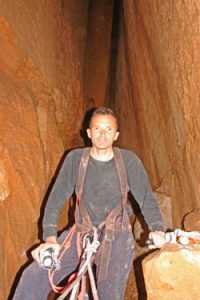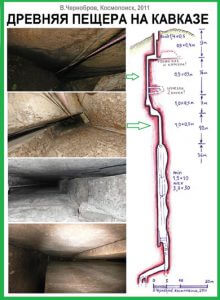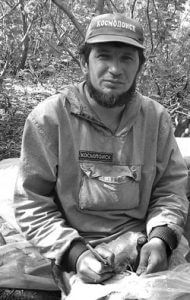 1
1

Arkaim and the texts of Rgveda about his builders
 25. 04. 2024
25. 04. 2024



 20. 09. 2016
20. 09. 2016

The end of 2011 was marked by another discovery of megaliths in Russia, this time involving the small village of Zajukovo in Kabardino-Balkaria. The little-known mountain village became the center of all possible world beliefs overnight; here they found the cosmic center, the place of opening the chakras, the solar observatory, and almost discovered the Holy Grail. Why did television stations, homelanders, and various avid researchers investigating mysteries suddenly flock here?
Nowadays, we basically can't expect any major discoveries on the mainland. The last bastion of white places remains caves and they are waiting for their Columbus or Amundsen, but with special speleological equipment. News of the discovery of a mysterious cave in the North Caucasus began to appear in the world media between September and October 2011. It was very difficult to know the layers of truth and thought from the beginning, all the more so as journalists almost "went crazy" and began to spawn TV shows and articles - one more sensational than the other. We all remember the commotion around the Ukrainian (Crimean) pyramids, which has grown to enormous proportions. Therefore, it was difficult at first to believe that a huge artificial cave had been discovered at the foot of Elbrus, which the Nazi expedition had already sought and found. But when the journalists calmed down and stopped supplying a flood of unverified and fictional information, interesting facts could finally be drawn from it, which the Kosmopoisk experts set out to examine.
Kosmopoisk's expedition was to examine the legends of the underground cities, and they added fresh news from the press. They surveyed in the Caucasus from June 4 to mid-July 2011, then individual members returned there during August. During that time, they did a piece of work and, among other things, they managed to clear the collapse, get into the cave and start mapping the underground complex.
He first discovered the corridor leading to the unknown, local villager Artur Žemuchov, a climber and speleologist. The popularity of the finding was "taken care of" by husband Marie and Viktor Kotlajarov, historians and homeland.
 The found entrance to the unique underground consists of a vertical shaft, measuring 40 x 90 centimeters in places, consists of several parts and there are transitions between them. It resembles a flue, hidden underground and belonging to a mysterious giant. If it turns out to be the work of human hands, it will be the largest prehistoric building in the territory of the current Russian Federation.
The found entrance to the unique underground consists of a vertical shaft, measuring 40 x 90 centimeters in places, consists of several parts and there are transitions between them. It resembles a flue, hidden underground and belonging to a mysterious giant. If it turns out to be the work of human hands, it will be the largest prehistoric building in the territory of the current Russian Federation.
Speleologists Igor Kommel and Pavel Sofjin were among the explorers who descended into the cave. According to their description and the schemes of the Kotlyarov family, the first plans of the cave were created. The unexplored cavity in the rock continued to surprise climbers and speleologists, they had never seen anything like it in the former huge spaces of the USSR. The crooked and narrow manhole, which could hardly be extended, proved to be the "neck of the bottle." There is about 100 meters in the highest part between the upper and lower parts of the cave, the length is stated to be 36 m in some sources. Exact measurements have not yet been made.
Despite the first stunning impression of the chimney-shaped and deep-leading entrance, the final conclusion that it is an artificial building is still early. To date, we have reason to believe that the walls have been worked and that heavy stone blocks, similar to those of the Egyptian pyramids, have been used in the construction of the underground space. But we can also assume that we are looking at the admirable prank of nature.
The head of the geological exploration expedition to these places, Věra Daviděnková, claims that the rock in the Zajukov area is formed by volcanic igneous rocks - ash, lava, volcanic glass and to a small extent fragments of rocks from the crater walls. At the time of the eruption, all components were red-hot and wrinkled during cooling, so that the tuff massif gave the impression that these were individual blocks. Thus, the recess at Zajukov is formed by such gravitational tearing, which is characterized by flat connecting surfaces. Albert Jemkužev, head of the administration of the mineral wealth of Kabardino-Balkaria, also agreed with Daviděnková, although he adds that prehistoric people could also use the cave.
However, some other circumstances contribute to the hypothesis of a megalithic nature of the North Caucasus discovery. The Kosmopoisk expedition was organized because of local legends, which were passed down orally among the elders, who claim that there are underground cities in the area. These myths could therefore have a real basis in real events dating back to ancient times.
Speleologists were able to view and photograph the connections between the rectangular "blocks" in the cave. The journalists from REN-TV, who were filming a documentary here, scraped some "mortar" from the joints and handed it over to Alexander Pankratenko, a doctor of technical sciences and professor at Moscow Mining University, who confirmed that it was a type of connecting material. Viktor Kotlyarov, author of more than 50 books on the history, ethnology and orography of the Caucasus, claims that he showed images of the cave to many geologists - even foreign ones, and most of them are in favor of a version about its artificial origin. "And everyone agreed that they had never seen anything like it before," the historian emphasizes.
Various hypotheses about the purpose of using a mysterious shaft and underground are many: the burial site of infected animals, the food storehouse, the Aryan dwelling, the energy resonator, the remnants of the ancient well, even the Red Army fortifications, and more ...
Vadim Chernobrov, coordinator of the Kosmopoisk association, favors the version that the cave belongs to megalithic buildings and is one of the largest man has built. Unfortunately, no organic remains were found to help determine the period when the "underground city" was used. So far, no evidence has been found that it was a human dwelling. The only indirect confirmation, not yet verified, that this place was used as a shrine, appeared only after the end of the Cosmopoisk expedition, when local researchers found something like a necropolis and astronomical observatory near the cave. However, the findings need to be thoroughly researched and archaeologists involved.
Not to be overlooked is another fact, both in the documentaries and in the press, that the German organization Ahnenerbe was very seriously interested in this position. Evidence of this are carved swastikas with dates around the cave. The Ufolenty correspondent asked Vadim Chernobrov about the veracity of this statement:
 "The topic of German activity in these parts still does not allow any of the local researchers to sleep. They are convinced that Hitler considered the Caucasus to be the "center of the Force" and a place from which the whole world could be controlled. None of them is willing to believe that Hitler rushed to the Caucasus for oil or any other trivial reason. Many are still looking for traces of the presence of the Nazis, who tried to decipher the esoteric secrets here. We won't judge whether they're right or wrong, maybe there really are seven swastikas somewhere, but I haven't seen them. In addition, there are even more fantastic versions regarding the search for Germans in the Caucasus. In any case, I would not yet connect the cave with German history. First, the Nazis were obviously not in the cave, nor could they build it (they did not have the necessary technology then, as we do today), and they did not have the time, only in the autumn of 1942, after which the Red Army ended all their searches. "
"The topic of German activity in these parts still does not allow any of the local researchers to sleep. They are convinced that Hitler considered the Caucasus to be the "center of the Force" and a place from which the whole world could be controlled. None of them is willing to believe that Hitler rushed to the Caucasus for oil or any other trivial reason. Many are still looking for traces of the presence of the Nazis, who tried to decipher the esoteric secrets here. We won't judge whether they're right or wrong, maybe there really are seven swastikas somewhere, but I haven't seen them. In addition, there are even more fantastic versions regarding the search for Germans in the Caucasus. In any case, I would not yet connect the cave with German history. First, the Nazis were obviously not in the cave, nor could they build it (they did not have the necessary technology then, as we do today), and they did not have the time, only in the autumn of 1942, after which the Red Army ended all their searches. "
We cannot rule out the natural origin of the cave and the "blessing" of the ancient inhabitants of these places, such as the Sosruko cave. The answers to many questions will only be given by new in-depth research and future findings, hidden in the number of branched and crooked labyrinths that lead from the cave.
illustration video